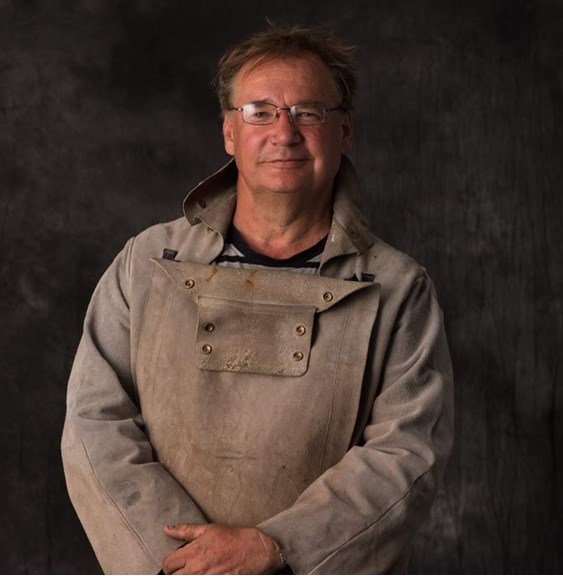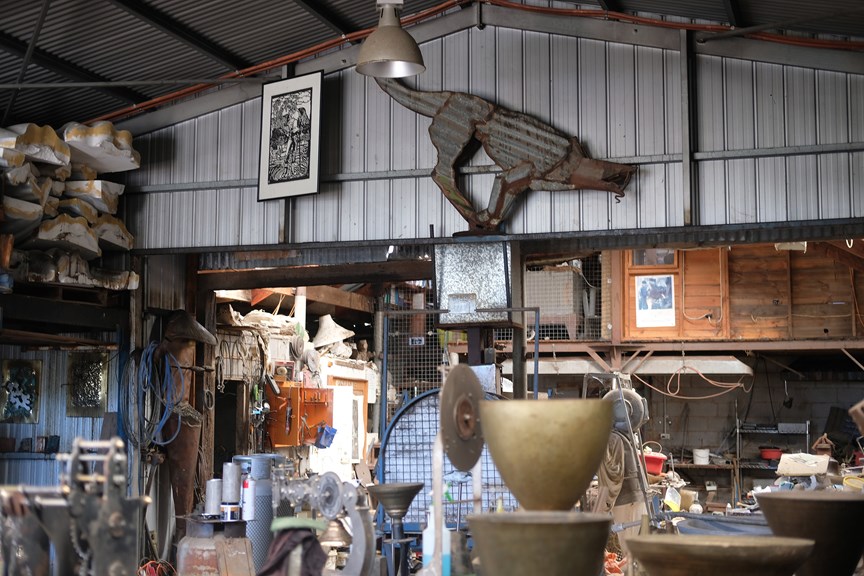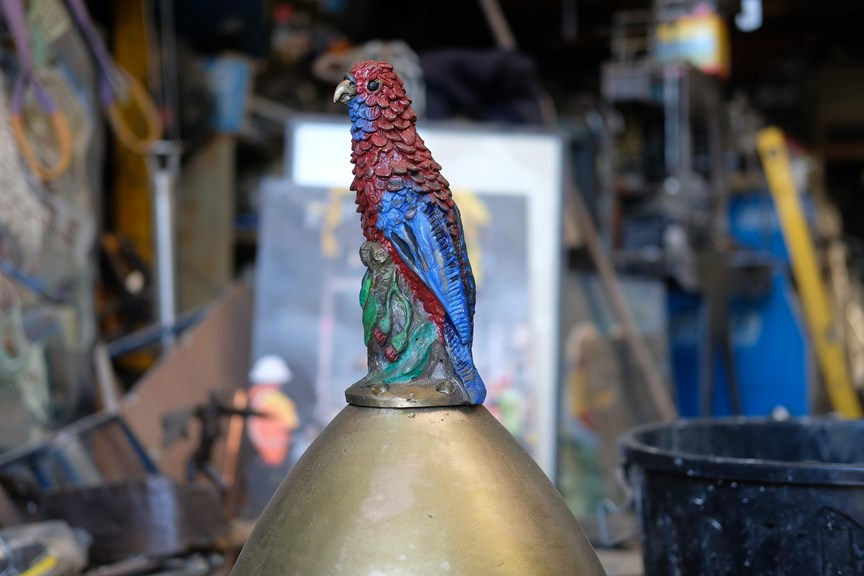Interview with Anton Hasell
In the late 1990s, Anton Hasell, a multi-disciplinary artist and Neil McLachlan, a researcher in auditory and music neuroscience, were commissioned by Arts Victoria to design and create the Federation Handbells.
During the early stages of development, the designers travelled extensively across Asia and Europe, researching bells, design, art and music. Drawing on both traditional and contemporary methods of design and craftmanship, Hasell and McLachlan created the first true harmonic bell. Unlike church bells, which usually produce a chord-like sound, the Federation Handbells produce a single clear musical tone.
In 2022, Federation Handbells Senior Program Officer at Museums Victoria, Grace Terry, visited Anton Hasell's studio in Regional Victoria, where she had the opportunity to ask him about all things bell related.
What inspired you to study and work with bells?
I was teaching in the Sculpture Department of the VCA in 1989 when a student asked about the making of bells. The Sculpture department staff shared the bits of information they had about bells with the student and with each other. In all of the years of casting sculpture in bronze, including exploring the casting cannons, I had never wondered about bell founding, a strange, esoteric and inaccessible part of the foundry industry rarely talked about. In a remarkable coincidence, the percussion group ‘GongHouse’ approached me in 1990 to see if I, and the VCA, would help them cast a set of bronze gongs.
Several years after that project, I began making some of my landscape/seascape sculptures as small cast bronze bells to see how bells actually worked. A commission was advertised in 1994 for a public artwork to celebrate Vision Australia’s centenary celebrations. I won that commission with a proposal for three sculptured bronze bells on a bronze post with a bell-shaped base in which three movement detectors that would ring small solenoids under each bell. The sculpture is in Kings Domain Melbourne, near the Myer Music Bowl.
My Vision Australia commission gave Neil McLachlan and I the money to access the software. Our experimental castings in my studio made clear there were new design possibilities in bell research, so I began a PhD in bell design at RMIT University’s Architecture and Design program, where Neil was a sessional lecturer, in 1997. We unsuccessfully applied for an ARC research grant; amazingly however, Neil and I were commissioned in 1998 to undertake the Federation Bells Project by Sir Jonathan Mills AO, Artistic Director of the Melbourne International Arts Festival.
What is the Australian bell-making industry like today?
I hear from artists now and then who are making gongs, singing bowls and bells. I encourage their continuing experimental research into idiophonic design for the kinds of sounds that they enjoy. Australian Bell [Editor's note: Anton Hasell and Neil McLachlan founded Australian Bell; however, the company is now independently owned by Dr. Hasell] is becoming better known for the work that I do in bell design, with a number of commissioned projects like the HMS Beagle Ship Bell Chime in Darwin and the four experimental bells for Cowes in Philip Island. Between 2014 and 2017, I was asked to invent a new bell design, the difference-tone bell, by Danny Hillis who was designing the 10,000-Year Clock constructed inside a mountain in Texas (www.longnow.org/people/clock).
Australian Bell seeks to be the leading edge of bell research and experimentation using the most recent digital software and engineering technologies, and so hopes to create new, yet to be imagined markets for bell designs that assist communities to stay relevant, and responsive, to social and economic challenges and the essential change this requires. Australian Bell sees a growing place for an acoustic overlay in contemporary urban design for community wellbeing.
How do you see the future of bell design and manufacturing?
It is my conviction that engineering software like FEA (Finite Element Analysis) opens up new possible sounds from new possible bell profiles. Some designs are too complex to be cast with traditional foundry technologies, and my work with Dr Daniel East at the CSIRO on 3D printing bells in titanium and stainless-steel offers manufacturing technologies that do allow the most complex designs to be manufactured, though at a significantly higher cost than conventional foundry processes at this early stage of the technological development.
I am seeking opportunities wherever I can draw project funding to new bell design in new metals using 3D printing processes. This is absolutely the future for bells in community life. I have worked with a number of Australian companies working in FEA engineering and new projects enables me to bring together CSIRO’s 3D printing in metal with these digital Engineering companies for new sounds from new bell profiles in new materials and fabrication processes.
Anton, you have previously mentioned that developers, town planners and architects should be looking at new and innovative ways to incorporate acoustics, such as bells, into built environments – can you discuss why this is so important for our health and well-being?
The traditional use of bells as religious objects is in a slow decline. European bell foundries cater to that market and see only a very small market for new design musical bells, so see little sense in the work I am undertaking. Bell foundries 200 years and older are closing down in Europe. Apart from the intrinsic joy of research for its own sake, I am convinced that bells can still contribute to community wellbeing beyond their role in religious ceremony.
Contemporary urban design has its acoustic concern primarily in the problem to be solved of ‘noise’. Resolving intrusive noise in the built environment is important, but profoundly more important is for urban design to have acoustic overlays that can guide both specific and ambient noise reduction, but also control special sound experiences across urban spaces. An important part of this is to furnish the means for community members to shape the kinds and volumes of sound themselves in particular places.
My experimental research is oriented to a new space for bell sounds in community living, as ‘place making’ and ‘way faring’ listening experiences, as sites for absolute silence, and sites for musical dancing hysteria, and the same sites for all kinds of listening experiences between. All craft/design/art (indistinguishable categories) expression and experience have a social contract with the community supporting them. Creative, imaginative designers ought to change-makers through which the community can formulate and negotiate change and explore/make adaptations to suit changing future social and economic requirements.
Bells need not be esoteric nostalgic artefacts of past glories, or religious certainties, but can be vibrant innovative contributors to a community’s vitality and wellbeing as it navigates toward a sustainable future through change and adaptation. The creative industries are the engines of community wellbeing and their social and economic prosperity. Acoustic overlays in urban design, and bells, have their part to play in these important processes.
[Editor's note: This is an extract from an in-depth interview with Dr. Anton Hasell of Australian Bell.]


